Last updated: October 14, 2024
Article
Uncovering Ungulates: The Search for Bison in Glacier
By Kristin Vinduska
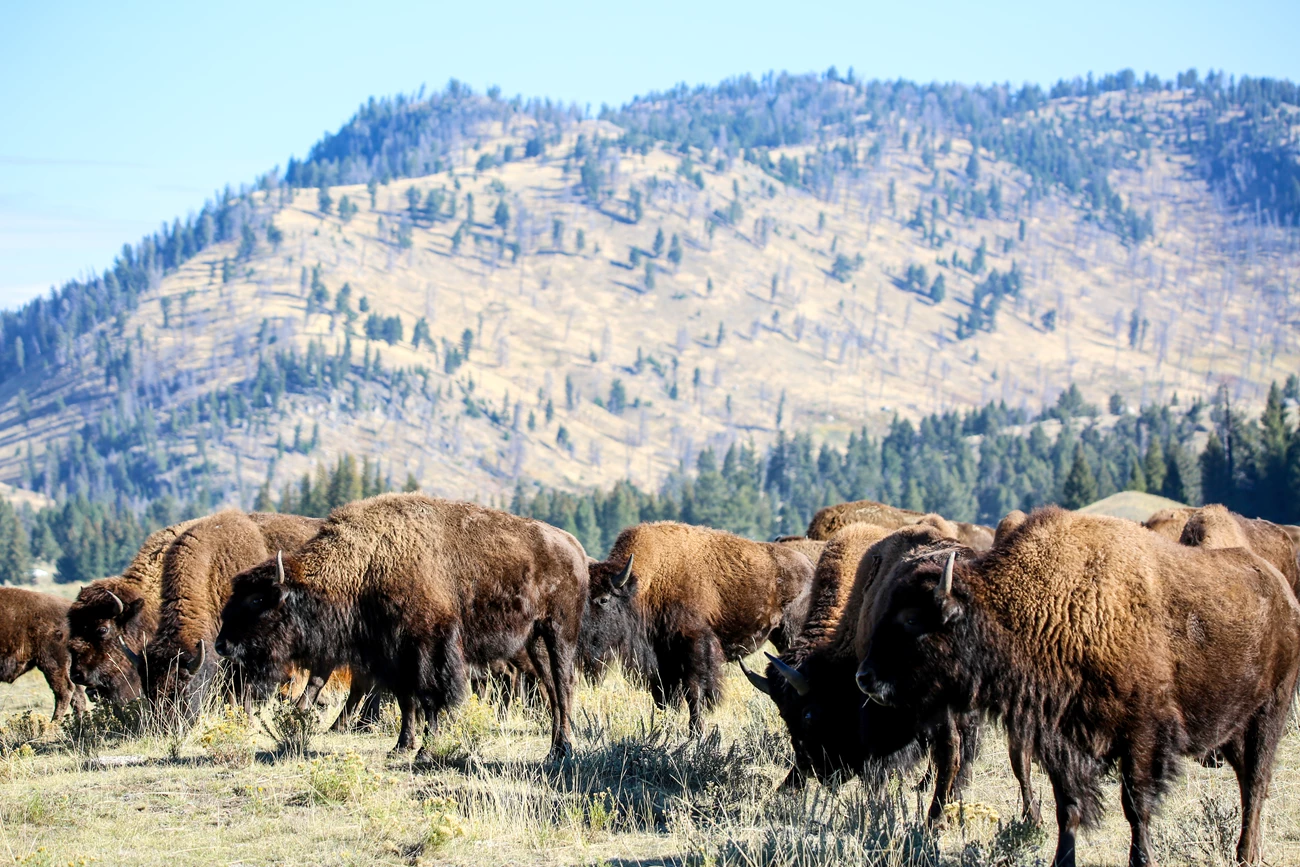
NPS/Kristin Vinduska
The light rustle of the grass shifting like waves in the wind is one of the only sounds I can hear besides my hiking boots crunching on the varied rocks, dirt, and leaves beneath my feet as I am led on journey to solve a mystery. The clues to this mystery are eroding out of the cutbanks of waterways and melting out of ice patches. It is an enigma that spans elevations from the prairies into mountains as high as 7,000 to 8,000 feet. This mystery exists due to a species disappearing from the area by no fault of its own. A part of me wonders what it would be like to witness this powerful creature inside Glacier National Park (from a safe distance) …to hear the light rustle of the grass turn into a rumble of hooves thundering across the landscape. As I envision what this might look like, Glacier National Park Archeologists Kyle Langley and Brent Rowley, inform me we have made it to the spot they are investigating for the day.
The question they are hoping to answer is how bison historically used this landscape for the last 10,000+ years. Along with this information, they hope to better understand the cooperative nature of bison hunting. Langley and Rowley do this by collecting samples of bison remains eroding out of the ground and melting out of ice patches to send to a lab for radiocarbon dating and stable carbon isotope analysis. The radiocarbon dating will determine the age of the remains. The stable carbon isotope analysis will reveal the types of plant material the bison were eating. The best results can be yielded from bison horns or teeth. This is because these samples best retain the carbon of the plant materials that the bison ate throughout its life. The primary food in the bison’s diet will provide an insight into what elevations the bison were spending most of their time while they foraged for food based on the places the plant communities are found. For example, if the primary food source was found to be a mountain shrub diet versus a tallgrass-prairie diet, this would provide evidence that this bison spent most of its time foraging in the mountains. Results of these sample collections will also help us to gain a better understanding of how bison were traveling throughout the landscape during a specific time period when the information from both the carbon dating and carbon isotope analysis are combined.
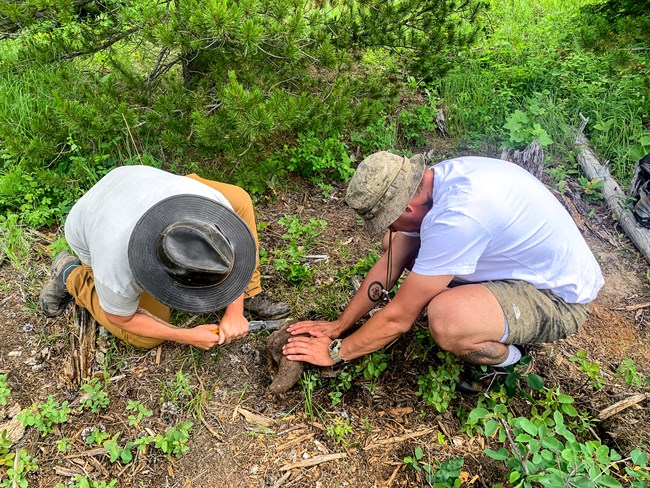
NPS/Brent Rowley
Langley and Rowley know some locations of bison remains thanks to park staff who had previously discovered many of these remains and documented their locations. Langley remarks about collecting the samples, “Finding the bison teeth in a landscape such as Glacier can be as challenging as it is rewarding. Glacier has rugged topography and dense vegetation that make recovering things such as faunal remains and other artifacts difficult at times. But it also means getting to backpack, climb, and even packraft to access remote locations in the backcountry, which is of course wonderful. Compiling all the data was originally my graduate research thesis, and it has since become an ongoing project to keep our map updated as we collect new data. The result is that we have a much clearer picture of where bison once roamed within the present-day park boundary.” Langley’s thesis focused on mapping evidence of historical bison presence and bison hunting in Glacier National Park using ArcGIS software.
Being an advocate for park protection and for following Leave No Trace principles, I wondered how they were able to collect these samples as I had always been taught by the National Park Service to “Leave What You Find.” Langley and Rowley explain while that is true for park visitors, park resource managers must determine the best way to preserve the integrity and context of paleontological resources. Since these remains are on the verge of eroding out of waterway banks and melting out of ice patches, they are at risk of losing their context and meaning. Collecting the samples now and carefully documenting the place and position of the remains can provide clues as to age and use of the object. In this case, the places where these remains are found can give context about if these were locations the bison were hunted. This is done by identifying terrain features that might be advantageous for bison hunting by the Indigenous People who inhabited the area for thousands of years.
While I was out searching with Rowley, I was excited to spot a button that appeared to be giving in to the elements and the breakdown of time, but I could make out the faded words, “A. J. Tower Co. Boston.” Proudly ready to show off my discovery, I called Rowley over. It was amazing to get to see the park, even if just a glimpse, through an archeologist’s eyes as we discussed this button. Their ability to read the landscape as if the curves of the hills and bends of the creek were words coming together to tell the story of its past and the objects remaining within it. Rowley then excitedly called to me to show me pieces of flakes that he had found that were most likely the left-over pieces that had been discarded after creating a stone tool or weapon. These finds made me wonder about the people who had left these things behind. What kind of life did they lead? Were they as inspired by their surroundings as I am? It served as a reminder to me to keep these discoveries intact so they can keep telling the story of people who came through and inhabited this area.
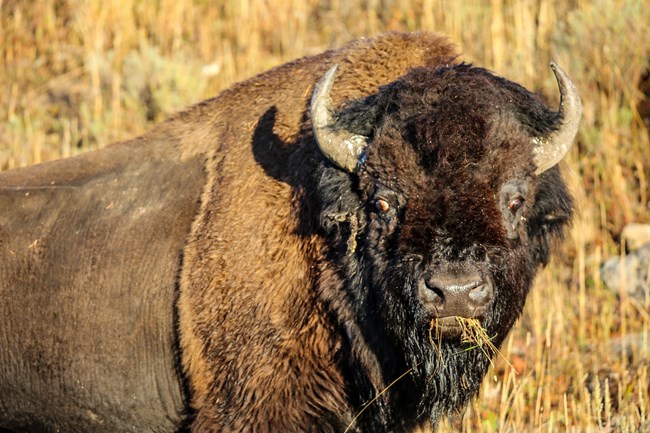
NPS/Kristin Vinduska
Although no bison inhabit the park today, they were once a common species in the rugged mountains and sweeping plains in and around the east side of Glacier National Park. Rowley and Langley explain that studying bison in Glacier National Park is a unique opportunity to uncover information on a topic not much is known about: bison in the mountains. Growing up in a plains state, I had never pictured these unruly ungulates in the mountains before as I had always experienced them in wide-open spaces of rolling flint hills throughout my youth. Evidence suggests that bison utilized both the “pastures of plenty” for grazing and the thick shelter of the wooded mountains throughout the year, some even preferring to stay in the mountains year-round, since the mountains could provide timber cover and grasslands. As these bison roamed across different elevations they served as a culturally important animal to many Indigenous People in the area and still do to this day.
Physical evidence of human use dates back more than 10,000 years within the boundaries of Glacier National Park. The area encompassing Glacier National Park is a portion of the traditional and ancestral homelands of the Umsskáápipikani, Ktunaxa, Séliš, and Ql̓ispé People, who are the original stewards of this land. Historical reviews of people on this landscape highlight that they have co-existed with bison for their entire history. As Langley stated in his thesis, “Bison and bison hunting are fundamental elements of the cultural systems of many Indigenous cultures of Montana.” The traditions associated with bison hunting included songs, dance, and other ceremonial tasks.
Nearly all forms of pre-modern bison hunting required utilizing landscape and terrain features to the hunter’s advantage. Strategies involved moving bison into terrain features where they would have less ability to charge or escape to allow hunters to get closer and be more accurate. These terrain and seasonal features in Glacier National Park could have included marshes, wetlands, meadows on sloped alluvial fans, frozen lakes, and snowdrifts. Human-built structures such as corrals were used by tricking the bison to enter these spaces through a drive line and into a trapped space where they could be easily hunted. Locally, the use of bison jumps is not likely due to the lack of suitable terrain. Single use hunting of isolated bison could have also been employed. New methods of hunting have developed over time including the use of horses and more modern weaponry. Presently, there are no bison in Glacier National Park. In the mid 1800s as settlers moved through the area, extreme overhunting of bison became a detrimental issue, almost leading to their extinction.

NPS/Kristin Vinduska
Today, people in the Blackfeet Nation are working to bring iinnii, or bison, back to this area. For members of the Blackfeet Nation, “bison gave strength to the tribes, providing lodging, clothing, food, and the foundation of spiritual and social relationships.” In 2009, an effort called the Iinnii Initiative was created by leaders of the four tribes that make up the Blackfoot Confederacy (Blackfeet Nation, Kainai Nation, Piikani Nation, and Siksika Nation) “to conserve traditional lands, protect Blackfeet culture, and create a home for the buffalo to return to.” The Blackfeet Nation Bison Reserve currently serves as a home to around 800 bison. The first 88 bison to return were from Elk Island National Park in Canada. They are descendants of bison that were originally from this area and were sent to Elk Island over a hundred years ago. This transfer of bison marked an incredible homecoming. The Reserve promotes, “bison restoration, wildlife habitat conservation, food sovereignty, ecotourism, culture revitalization, and more.” The Blackfeet hope that brining innii back will allow future generations to experience iinii on their native landscape and learn about their cultural importance. Another goal is to allow these mighty creatures to roam freely and return to Glacier National Park.
This connects back to Langley and Rowley’s work because they are trying to learn more about what areas bison frequented in the past which can give managers clues about where bison might roam in the future if they are to return to their historic stomping grounds. In August, they sent off samples to the University of California, Irvine Keek Carbon Cycle AMS Program to be tested. The lab ran two sets of tests on the 22 bison samples made up of sixteen teeth and six bone. First, the lab performs a radiocarbon dating which yields a radiocarbon age of the sample using known decay rates of carbon 14, with a margin of error of plus or minus 15 years. Then the lab conducts stable carbon isotope analysis, which helps confirm the accuracy of the radiocarbon dating and provides insight into the diet of the bison that the samples belonged to. The remains from a bison contain an aggregate record of the types of vegetation the bison browsed on. This gives new meaning to the phrase, “You are what you eat.”
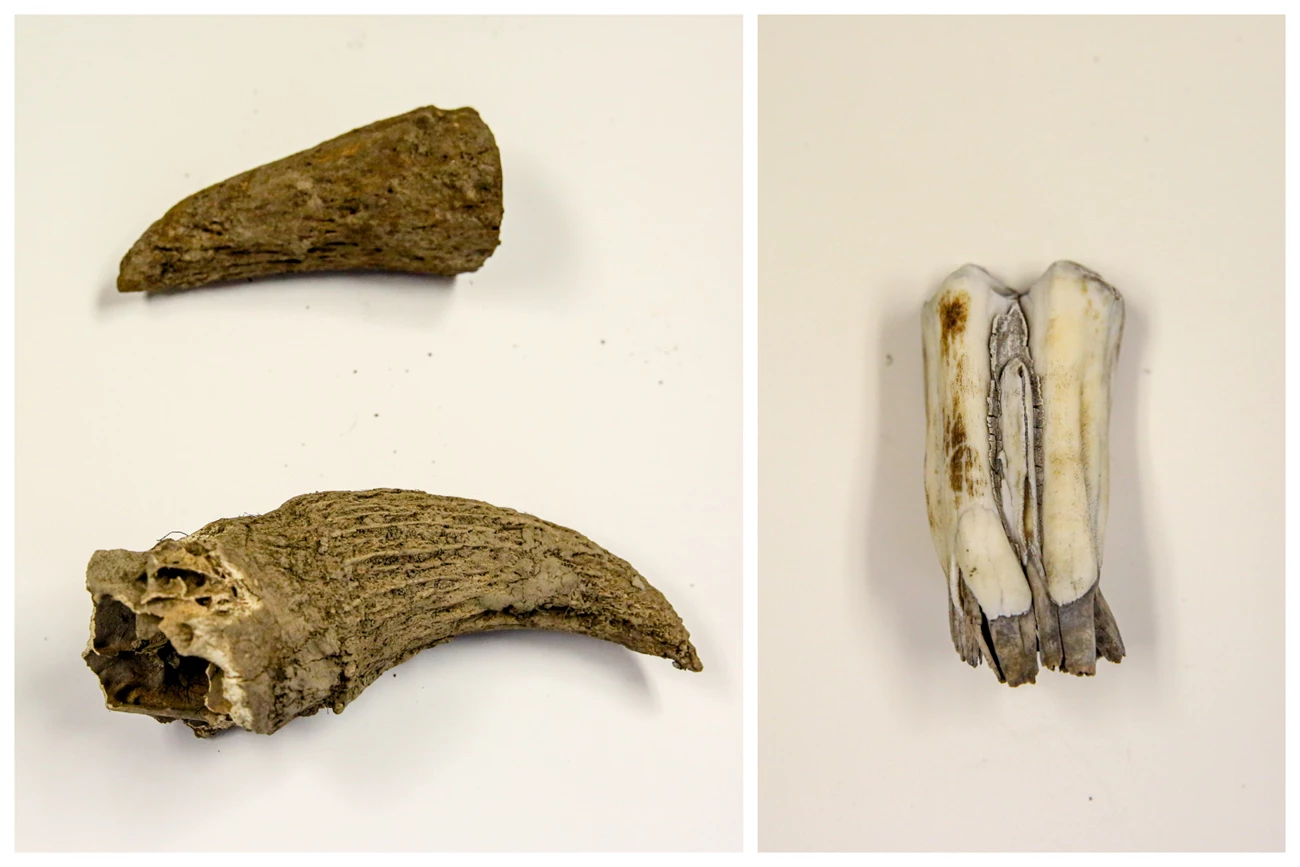
NPS/Kristin Vinduska
Information from the stable isotope data, should be available next spring as they factor in local grasslands. An initial review suggests that all the bison here were browsing mostly C3 vegetation versus C4, consistent with higher alpine plants. Thus, it may be possible to prove that bison in Glacier actually spent most of their time in the park as opposed to out on the plains. Comparing these results to local modern bison populations would help solidify the information. Samples from six geographic locations were used for radiocarbon date results. Two of the bison teeth from Many Glacier came back with radiocarbon ages of around 180 years ago (around the mid-1800's). One tooth from Many Glacier was just over 2,000 years old. The oldest tooth came from a high alpine snowfield in the St. Mary area, dating to around 4,400 years ago! Many samples from an archeological site in the Belly River were also tested, and all the dates for those fell between 1,000 and 1,100 years ago. Glacier National Park employees are hoping to continue this study in the future with additional samples from more locations, if funding can be secured.
Langley said of the importance of bison on the landscape, “Bison should be one of Glaciers iconic animals, alongside the grizzly bear or mountain goat. Furthermore, bison have always been incredibly important to the people who have lived in Glacier for thousands of years. Unfortunately, because of the near extinction of bison in the 1800s, most folks have no association with Glacier and bison. This research helps us in a small way to correct that error, as it proves beyond a doubt that bison were here.” As I look back on my opportunity to tag along for this project, I am thankful to everyone who is working to uncover more information about this unique ungulate and return it to its home so that we all may get the chance to hear that rumble of hooves in this iconic landscape.
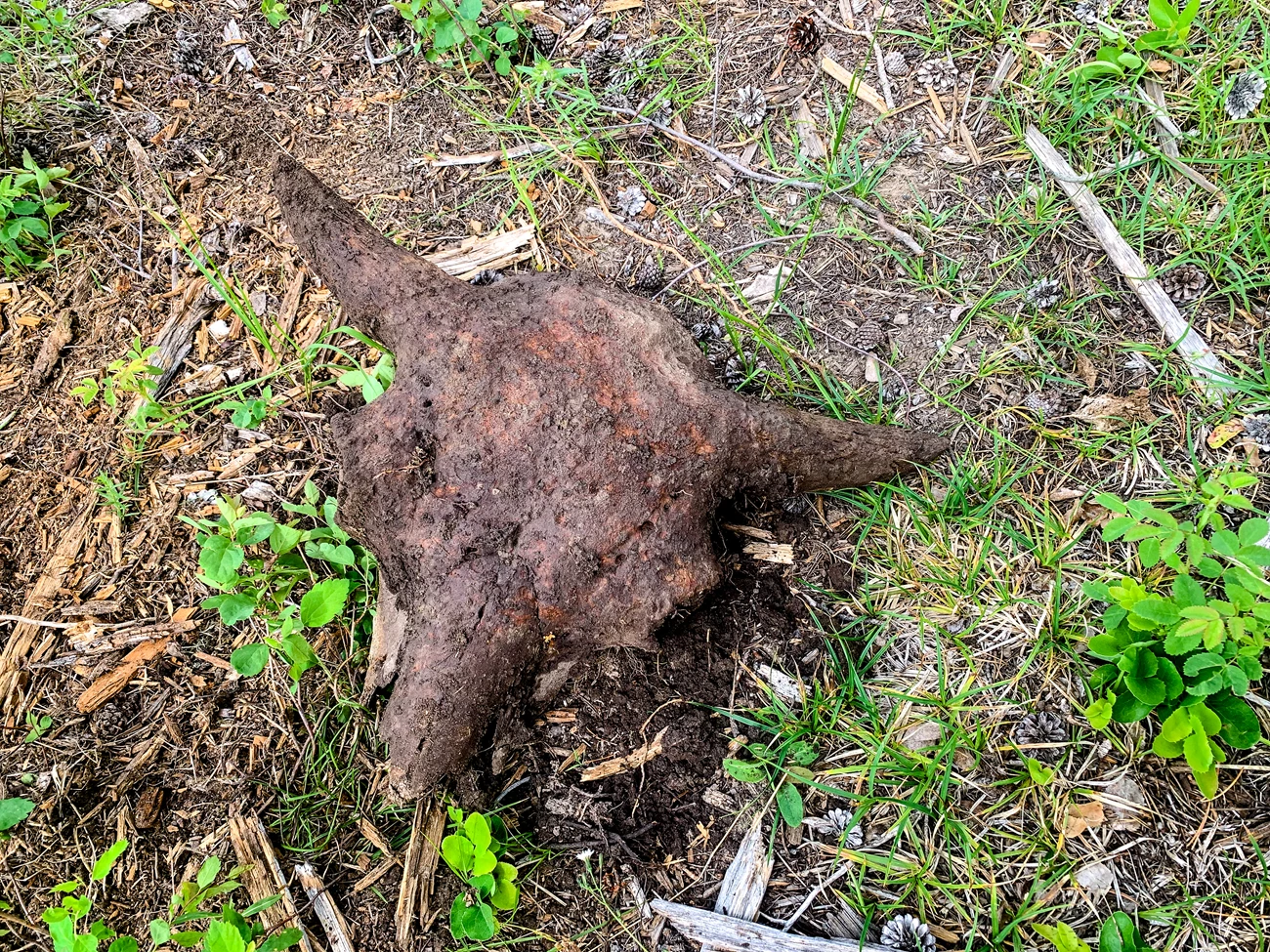
NPS/Brent Rowley
